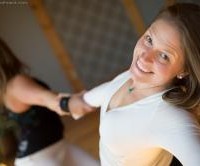Photo: Lululemon Athletica
A few months ago I started noticing there was a little discomfort in my wrist even in a mild pose like hands & knees (also known as table pose).
I would slightly change the poses at the beginning of my yoga practice to alleviate the discomfort. Then, one day, about two months later, I couldn’t put weight on my left wrist with my palm on the floor at all. In the past, when I have experienced a mild to medium disease or borderline injury I have taken the opportunity to take a full-fledge break—switching to running, swimming or pilates.
Injuries are always frustrating, confusing and sometimes something so small seems to take over my life, especially because I am professional yoga teacher. This one was no different, although this time I was downright indignant.
I teach four to five classes a week and need to practice before I teach. Many of my yoga teachers have often spoken about learning from your injury, teaching from the wisdom that it can offer. This was always a hypothetical for me, and I figured that was after you returned to full health.
I was feeling gimpy, inadequate and frustrated as I wondered, “How can you practice from that? How can you teach from that?!” Life and my classes were continuing with or without me.
Then one of my teachers said, “You will figure out that there is always a yogic practice for whatever is going on in your life—whether it be pranayama, sickness or depression. There is always something.” I was stunned, and it seemed so obvious.
Focus on what you can do, not what you can’t.
I finally decided, after a visit to my acupuncturist, that I would stay away from putting weight on my wrist in extension for eight weeks. This removed plank, chaturanga (the yoga push-up), arm balances and handstands from my daily practice; which was a big part of my day-to-day routine. After a week, I suddenly noticed I was occasionally demonstrating these poses in class while teaching (this is still the most difficult hurdle in my recovery).
The commitment to myself was going to be harder than I expected, until I shifted my focus to other poses: balancing and extension poses like utthita padagustansana (hand to big toe pose); forearm stand; frog; headstands.
I was beginning to get creative and look at the hundreds of other poses, rather than focus on the scarcity of the issue.
I was focusing on flexibility and opening up my shoulder girdle, which brought a new softness to my personal yoga practice and teaching.
My change in perspective was opening up new possibilities and altered my emotional state as well by focusing on the positive, rather than the one perceived negative.
And then don’t blame the bridge…
Our attitude toward a place of injury is usually quite negative and often places blame. It is common to hear the phrase, “oh this is my problem shoulder” or “I have a bad knee”. This phrase-ology would fundamentally imply that the knee itself did something wrong of its own volition.
My Tai Chi teacher says a chronic knee injury is due to an argument between your hips and ankles. We would never accuse a bridge blown up as a casualty of a war, a “bad bridge”– so the same perspective can be applied to the knee, shoulder, back, whichever part of the body ails you, especially if it is a joint.
We can look at the corresponding joints and muscles around the “challenged area”. I can’t blame my wrist. It is a small relatively weak joint that must overcompensate for my tight shoulder girdle and that I often push myself through a strong practice.
For the knee problems, strengthening the ankle and opening up the flexibility of the hip to discover the proper alignment of the knee in athletic pursuits and daily habits can alleviate many ails from within.
Finding a certified Feldenkrais, Alexander technique or Body-Mind Centering teacher can be absolutely illuminating (be ready to commit for at least one year—you have taken a lifetime to create these patterns in the body, give a few years to begin unraveling them). Many of us don’t want to listen that carefully, thoroughly and mindfully to the whispering creaks until they incapacitate the whole body.
Magic?
We can switch from a position of blame to one of curiosity and compassion. Many of my AcroYoga colleagues refer to a place of injury, or disease as magical because that place holds so much potential: an opportunity to listen deeply to the whispering discomforts of the body; to re-pattern that which is not working; to learn from within how to be more compassionate, nurturing and kind to our bodies first and foremost.
It can be easier, for me, to be nicer to others than it is to be nicer to myself, so if I am really truly kind to myself in every way that I need, I wonder how much easier it will become to be more friendly, generous and considerate to others?










Read 8 comments and reply